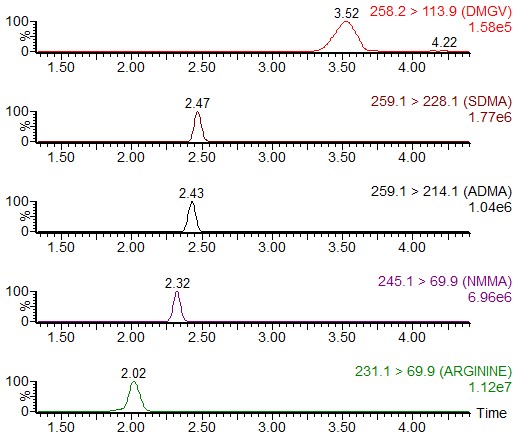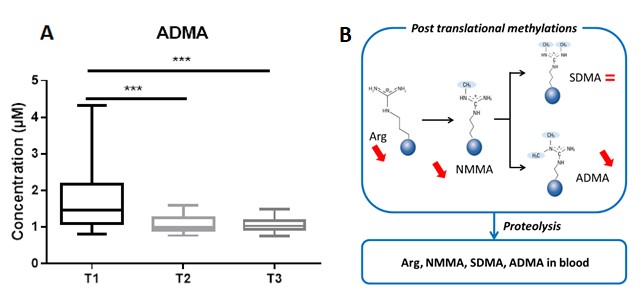|
Introduction
Post-translational modification of protein can lead to the production of asymmetric dimethylarginine (ADMA) which is a metabolite of arginine (Arg). After proteolysis, ADMA is released into the blood and interfere with Arg for production of NO (nitric oxide) which alters the endothelial functioning (Figure B2). ADMA is a strong biomarker of cardiovascular disease (CVD). It has been demonstrated in obese patient with insulin-resistance that ADMA concentrations are higher than healthy patients. Their life quality can be improved by bariatric surgery. The aim of this study was to access the modulations of ADMA and its metabolic partners after a sleeve gastrectomy or a by-pass intervention. To reach our objectives, we developed a fast and accurate liquid chromatography-tandem mass spectrometry (LC-MS/MS) method for the simultaneous quantification of Arg, N-mono-methyl-arginine (NMMA), symmetric dimethyl-arginine (SDMA) and ADMA.
Experimental conditions
Standard compounds were serially diluted in water to get 7 standard solutions ranging 0.04-2 µmol/L (ADMA, SDMA, NMMA) and 10-500 µmol/L (Arg). Then, 50 µL of an aqueous solution of labelled internal standards (D7-ADMA [5 µmol/L] and 13C-arginine [250 µmol/L]) were added to both standard solutions (20 µL) and serum samples (20 µL) obtained from 33 morbid obese patients (body mass index [BMI]: 44.4 ± 5,5 kg/m˛) before and after bariatric surgery. Then proteins were removed by precipitation with methanol (100 µL). Samples were centrifuged (12 000 rpm for 15 minutes) and the supernatant was dried under a stream of nitrogen. Dried samples were derivatized with butanol containing 5% of acetyl chloride. After incubation (30 minutes, 60°C), samples were dried again and dissolved in 100 µL of water containing 0.1% offormic acid. Compounds were separated on a BEH C18 reversed-phase column (1.7 µm; 100 × 2.1 mm, Waters) held at 55 °C with a linear gradient of methanol in water, each containing 0.1% formic acid (UPLC H-Class, Waters).Then, metabolites were detected by a triple quadrupole spectrometer (Xevo TQD Waters) equipped with an electrospray ion source (ESI) operated in the positive mode. Multiple reaction monitoring mode was used for the MS/MS detection of metabolites with the following transition (parentdaughter): ADMA (259,1 214,1), SDMA (259,1 228,1), NMMA (245,1 69,9 ) and Arg (231,1 69,9).
Results
ADMA and its main metabolic partners were successfully detected and analysed by LC-MS/MS in serum samples (Figure 1). BMI sharply decreased after bariatric surgery by 33.5 ± 4.6 and 32.4 ± 4.8 kg/m˛, 8 and 14 months after intervention. Figure 2A showed a significate decrease of ADMA by 36.3% 8 months after surgery, and this effect kept constant after 14 months (-37.8%). We noticed a decline of NMMA and Arg by more than 30%. However, no signification variations were found for SDMA (Figure B2). We found significant correlations between circulating concentrations of ADMA and NMMA (r = 0.81; p < 0.001), between ADMA and Arg (r = 0.58; p < 0.001) and between NMMA and Arg (r = 0.64; p < 0.001). We also found significant correlations between BMI and ADMA (r = 0.45; p < 0,001), Arg (r = 0.43, p < 0.001) and NMMA (r = 0.32; p < 0.01) serum concentrations, while SDMA did not correlate with these parameters (r = 0.07; p > 0.05).
Hence, we hypothesized that gastric intervention is able to recover correct level of those molecules. In fact, arginine-containing nutrients seemed to be in part less absorbed after surgery.
Conclusion
Our LC-MS/MS approach allowed quantification of ADMA and dimethylarginines directly associated with molecule of interest. This is a fast and specific method suitable for a better understanding of bariatric surgery effects on cardiovascular outcomes in patients who display metabolic disturbances.
|
|

Figure1: Representative LC-MS/MS chromatogram obtained in human serum.

Figure 2: ADMA concentrations measured before (T1), 8 months (T2) and 14 months (T3) after bariatric surgery (T2) ANOVA 1 paired test (n = 33) ***: p < 0.001 (A) and simplified scheme of arginine metabolism and variation of concentrations after bariatric surgery (B).
|




